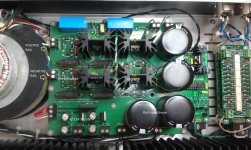I have just purchased a Blue Hawaii headphone amplifier (HeadWize - Project: Blue Hawaii Hybrid Electrostatic Amplifier for Stax Omega II Headphones by Kevin Gilmore) I'm a novice with electronics, having built a few solid state amplifiers. What I am finding is that I have a power supply MOSFET that is currently running ~20c higher than the other. I disconnected each channel of the amplifier and noticed that the MOSFET still ran considerably hotter, so I do not think it is an amp channel drawing far more current. That leaves bad component(s) in the supply I think. Any ideas on where I should start? This is the supply schematic: http://gilmore2.chem.northwestern.edu/images5/gilmore4_2.png This is a picture of what the amplifier looks like: http://gilmore2.chem.northwestern.edu/images5/gilmore4_4.jpg
Thanks!
Thanks!
Ok 'Grawk'. I am not sure what your issue is, but just because I made a poorly built amplifier -SIX- years ago and was banned on A DIFFERENT FORUM does not mean that I cannot solicit the opinion of a more competent forum regarding an amplifier that is obviously not performing as it should. Putting it simply, kindly go away unless you have something useful to contribute.
One MOSFET's heatsink on what I think is the negative rail is 20c+ hotter than the one on the positive rail. The reason why I disconnected each amp board was to check if one of the amp boards was causing additional load on the power MOSFETs. Since that did not seem to be the case as the same MOSFET heated up whether the left or right amp board was connected I suspected a component(s) on the supply board.
I hope I am answering this question correctly. Please let me know if I can clarify.
I hope I am answering this question correctly. Please let me know if I can clarify.
why is it hard to believe that one rail would have a larger current draw than another? Do you understand what grounded grid means?
I'd focus in understanding how basic circuit elements work, like resistors and diodes and then coming back to this "perceived problem" when you have gained a bit more understanding. It seems that you are not even sure which components form the "positive rail" and which are the "negative rail". Also, identify which componets are BJTs. Figure this out first and we can go from there.
I'd focus in understanding how basic circuit elements work, like resistors and diodes and then coming back to this "perceived problem" when you have gained a bit more understanding. It seems that you are not even sure which components form the "positive rail" and which are the "negative rail". Also, identify which componets are BJTs. Figure this out first and we can go from there.
Ok. Well, I'm not sure that commenting that I should go become an EE is a useful comment. If I was an expert on tube amplifier topologies I would have probably not asked the question. With that out of the way, why would a grounded grid topology be likely to cause a higher current draw on one of the rails?
Any other ideas on this one?
Any other ideas on this one?
Excellent. So, next what determines power dissipated through that device? For each factor, state whether or not it's a function of something on the PSU board or something on the amp board.
How long was the amp on when you took these measurements, and was there a load attached? Try keeping it on for at least half hour with a load and a signal and compare the results.
How long was the amp on when you took these measurements, and was there a load attached? Try keeping it on for at least half hour with a load and a signal and compare the results.
- Status
- This old topic is closed. If you want to reopen this topic, contact a moderator using the "Report Post" button.
- Home
- Amplifiers
- Tubes / Valves
- Having an issue with a MOSFET in my Blue Hawaii
 Gentlemen, keep to the topic. Personal attacks are against forum rules.
Gentlemen, keep to the topic. Personal attacks are against forum rules.